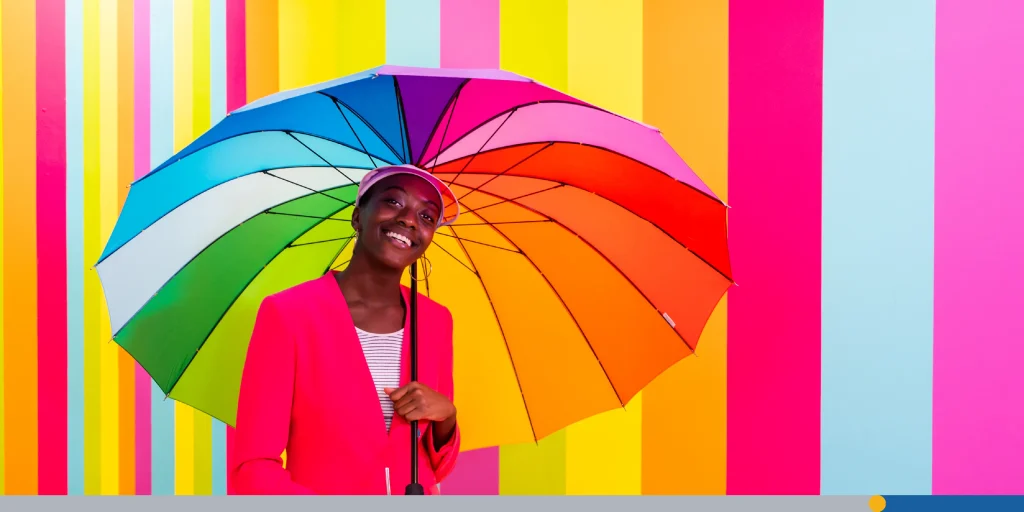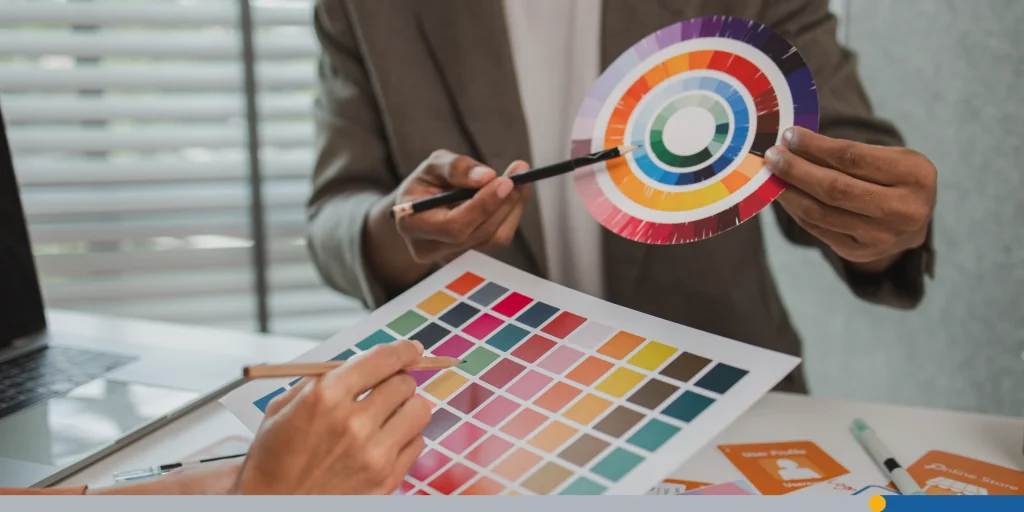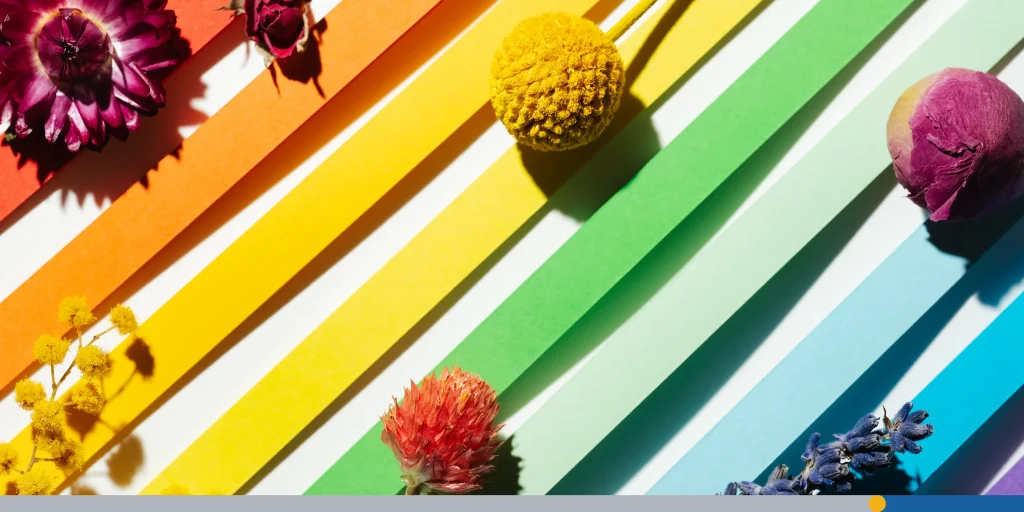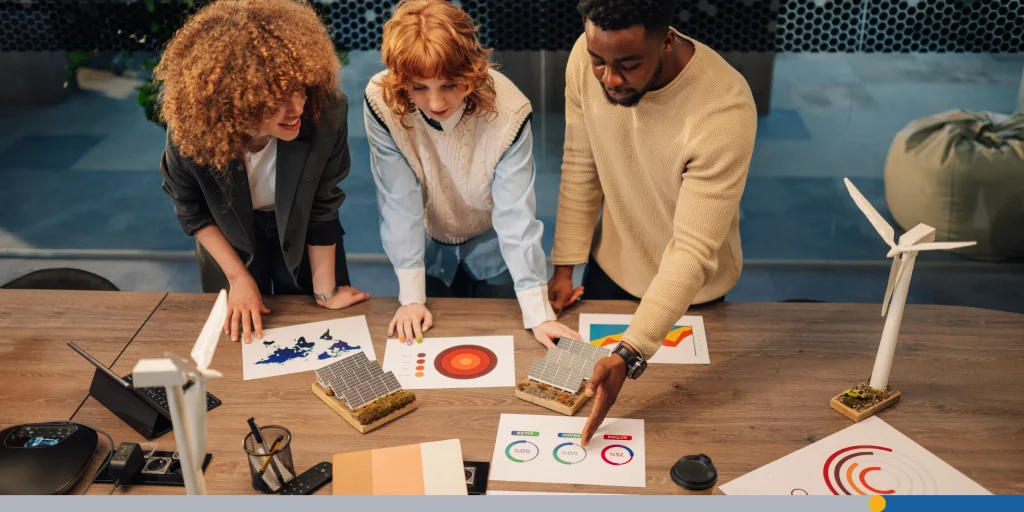Choosing the right color combination can take your logo design from basic to extraordinary. Nothing screams professional and polished quite like a logo that nails its colors. However, color selection is not arbitrary; there is science behind which colors work well together.
Yep, we’re talking about color theory, the magic behind how colors work together to make your brand memorable, recognizable, and emotionally engaging.
If you’ve ever wondered why fast-food logos use red and yellow or why tech companies lean heavily on blue, then you’re already brushing up against the basics of color psychology and theory. But color theory isn’t just about what feels good; it’s based on centuries of design thinking, science, and good old-fashioned experimentation.
In this article, we’ll explore the expansive world of color theory and how it applies to logo design. We’ll look at the color wheel, different types of color schemes, and how to mix and match shades like a pro.
- What Is Color?
- What Is Color Theory?
- The Color Wheel: A Designer’s Best Friend
- Warm Colors vs. Cool Colors
- Understanding Color Schemes in Logo Design
- Color Harmony: The Holy Grail of Logo Design
- Color Psychology in Logo Design
- Real-World Examples of Great Logo Color Theory

What Is Color?
This might seem like a silly question to ask, but before we dive into color theory, let’s take a second to discuss what color actually is.
Color is how your eyes and brain perceive light reflected in your environment. Light is a type of electromagnetic radiation transmitted in waves of energy all around you. But fear not, there won’t be a quiz on that later! All objects give off light, and different wavelengths create a spectrum of colors.
When an object reflects all visible wavelengths in the spectrum at once, you see white. When it absorbs all the wavelengths, you see black. Every other color comes from reflecting and absorbing wavelengths in a unique combination.
Since the brain processes different types of visual data separately, you perceive color before form, words, or motion. This is why color is such an important aspect of design. Studies have found that color can influence memory performance by increasing our attentional level.
What Is Color Theory?
Color theory is the study of how colors interact, how they influence emotions, and how they can be combined for aesthetically pleasing results. This helps designers create color combinations that make sense and look amazing.
We have Sir Isaac Newton to thank for the modern origins of color theory. In the 1660s, Newton first fully developed a theory of color based on a color wheel. Newton had split white light into a spectrum by means of a prism and then wrapped the resulting spectrum around on itself to create the color wheel. This led the way to the now common notion of red, yellow, and blue as primary colors.
In logo design, color theory helps you create harmony, balance, and contrast. It answers questions like:
- Should I use cool colors or warm colors?
- What’s the best accent color for my brand?
- Should I go with analogous colors or a complementary color scheme?
Whether you’re mixing red, blue, and yellow on a canvas or adjusting HEX codes in Adobe Illustrator, the principles of color theory remain the same.
The Importance of Color Theory
The color combinations explored in Newton’s color theory transcend aesthetics and can actually elicit a psychological and emotional responds. The Spanish painter Pablo Picasso said it best:
“Colors, like features, follow the changes of the emotions.”
However, it’s interesting to note that Picasso, like many other famous artists, did not subscribe to the rules of color theory and felt that color harmony was something that science couldn’t explain. Picasso famously said:
“Why do two colors, put one next to the other, sing? Can one really explain this? No. Just as one can never learn how to paint.”
In this instance, we have to respectfully disagree with Mr. Picasso. The foundations of color theory and the color wheel are useful tools for any designer building up their color scheme.

The Color Wheel: A Designer’s Best Friend
At the heart of color theory lies the color wheel, a simple yet powerful tool that organizes colors in a circular format. It shows relationships between primary, secondary, and tertiary colors, and helps you create visually appealing color palettes.
Primary Colors
These are the heart of the color wheel: red, yellow, and blue. You can’t create them by mixing other colors, but they can create every other hue in the spectrum.
- Mixing red and yellow creates orange.
- Mixing blue and yellow creates green.
- Mixing red and blue creates purple.
These combinations are the building blocks of secondary colors.
Secondary Colors
Secondary colors are made by combining two primary colors:
- Red + Yellow = Orange
- Blue + Yellow = Green
- Red + Blue = Violet (or Purple)
Each secondary color sits between the two primary colors that created it.
Tertiary Colors
This is where things get juicy. Tertiary colors are formed by mixing a primary color with a secondary color. These nuanced hues are a designer’s dream and can help create sophisticated and well-balanced logos.

Warm Colors vs. Cool Colors
Let’s talk temperature. Colors are often classified as either warm or cool, and each category can affect the viewer’s perception differently.
Warm Colors
Warm colors are red, orange, yellow, and everything in between. These evoke energy, warmth, excitement, and passion. Perfect for fast food brands (hello, McDonald’s) or anything that needs attention.
Cool Colors
Cool colors are blue, green, violet, and adjacent shades like blue-green or blue-violet. These convey calmness, trust, and professionalism. That’s why so many banks, tech companies, and health brands use cool colors.
Knowing when to use warm vs. cool is essential for effective logo design.
Understanding Color Schemes in Logo Design
Now that we’ve covered the color wheel, let’s dive into different color schemes you can use for your logo. These are predefined combinations of colors that work well together based on their placement on the wheel.
1. Complementary Color Scheme
- These are opposite colors on the color wheel.
- Examples: Red and green, blue and orange, yellow and violet.
- They create strong visual contrast and vibrant logos.
If you want your logo to pop, go for a complementary color combo. Think of FedEx using purple and orange; it’s bold and unforgettable.
2. Analogous Color Scheme
- These are adjacent colors on the color wheel.
- Examples: Blue, blue-green, and green or red, red-orange, and orange.
- They’re harmonious and soothing, making them great for brands that want to feel approachable.
Analogous color schemes are perfect when you want fewer colors and smooth transitions between shades.
3. Triadic Color Scheme
- These are three colors evenly spaced on the color wheel.
- Example: Red, yellow, and blue or purple, green, and orange.
- This scheme offers balance and color variety without clashing.
Triadic logos are dynamic but still harmonious, great for brands that want to stand out while staying unified.
4. Split Complementary Color Scheme
- A twist on the complementary scheme.
- You take a color and use the two colors adjacent to its complement.
- Example: Instead of just blue and orange, try blue with red-orange and yellow-orange.
This creates a slightly softer contrast and more options for variation.

Color Harmony: The Holy Grail of Logo Design
You’ve probably heard the term color harmony thrown around. It’s the sweet spot where colors look good together without clashing or feeling chaotic.
To achieve color harmony, you need to consider:
- Hue: The color itself (like red or blue)
- Value: How light or dark it is (think lighter shades like pastels or darker blues)
- Saturation: How intense or muted the color is
A color palette that’s too intense can overwhelm, while one that’s too muted might feel dull. Balance is key.
The Golden Ratio of Color: The 60-30-10 Rule
You’ve likely heard about the Golden Ratio before. It is a ratio between two numbers that equals approximately 1.618. The ratio can be simplified into the 60-30-10 to help designers with proportions. This rule can also apply to color schemes.
In a 60-30-10 scheme, a dominant color takes up 60% of a space, a secondary color makes up 30%, and an accent color fills the remaining 10%. This creates visual harmony and balance in the design, making it more aesthetically pleasing and comfortable for the viewer.
Using Neutral Colors & Accent Colors
While primary colors and secondary colors get all the glory, neutral colors like black, white, gray, and dark gray play an essential role in logo design. They’re the support crew, balancing vibrant hues and enhancing visual contrast.
If you want to draw attention to a part of your logo, use an accent color. This is usually a bold hue used sparingly to highlight an element. For example, a neutral color logo with a splash of red-violet or yellow-orange can be visually striking.
Mixing Colors Like a Pro
Creating the perfect color palette often means diving into color mixing. Here’s how it breaks down:
Additive Color Mixing (Used in Digital)
- Based on red, green, and blue (RGB)
- Used for screens, websites, and digital logos
- White light is created by combining all three
Subtractive Color Mixing (Used in Print)
- Based on cyan, magenta, yellow, and black (CMYK)
- Removing light to create color, hence “subtractive”
- Useful for color printing
Knowing whether your logo will live online or in print can help you choose the right system.

Color Psychology in Logo Design
This is where color theory gets fascinating, and deeply human. Beyond just looking nice, every color has the power to trigger emotional reactions, shape perceptions, and even influence consumer behavior.
Why Color Psychology Matters in Branding
In logo design, color psychology helps you align your visual identity with your brand values. For example, if your business is focused on wellness and nature, using green (associated with growth and calm) will resonate much more than an aggressive red or high-tech blue.
A Deeper Look at the Psychology of Colors
Here’s a more detailed breakdown of what common colors communicate:
Red: Passion, Energy, Urgency, Power
- Emotionally intense and attention-grabbing.
- Great for brands that want to evoke excitement, urgency, or love.
- Best used by: Fast food chains (like McDonald’s and KFC), retail (Target), and fitness brands.
Orange: Creativity, Adventure, Enthusiasm
- A friendlier version of red. Still energetic, but with a playful, approachable vibe.
- Best used by: Creative brands (Fanta, Nickelodeon), tech startups, and children’s products.
- Tip: Combine orange mixed with neutral colors for a bold, fun, yet grounded feel.
Yellow: Optimism, Happiness, Warmth
- Bright and cheerful, yellow makes your brand feel sunny and upbeat.
- Best used by: Brands that want to appear fun and youthful (McDonald’s, Snapchat, IKEA).
- Caution: Too much yellow can cause visual fatigue. Pair with dark gray or black for balance.
Green: Health, Growth, Nature, Wealth
- Evokes feelings of calm, freshness, and balance. Often associated with the environment and finance.
- Best used by: Wellness brands, eco-friendly companies (Whole Foods, Animal Planet), banks.
Blue: Trust, Stability, Calmness, Security
- The most universally liked color and the most commonly used in logos.
- Best used by: Financial institutions (PayPal, American Express), tech giants (Facebook, IBM), and healthcare brands.
Purple: Luxury, Royalty, Mystery, Imagination
- A mix of red’s energy and blue’s calm, ideal for high-end or imaginative brands.
- Best used by: Beauty, wellness, and luxury brands (Cadbury, Hallmark, Twitch).
Black: Sophistication, Power, Elegance, Authority
- Timeless, bold, and versatile. Used often in fashion, luxury, and tech industries.
- Best used by: High-end brands (Chanel, Nike, Apple).
White: Purity, Simplicity, Cleanliness, Freshness
- Makes a logo feel minimalistic and modern.
- Best used by: Health brands, tech companies, minimalist luxury (Apple, Adidas).
Gray: Neutrality, Balance, Calm, Professionalism
- A solid, neutral color that conveys sophistication without shouting.
- Best used by: Tech companies (Dell, Apple), law firms, consultants.
- Tip: Pair with bright accent colors like yellow-green or blue-purple for visual interest.
Cultural Considerations in Color Psychology
Colors can also mean different things in different cultures. In today’s day and age, it’s important to demonstrate cultural sensitivity when designing a logo.
Here are some examples:
- Red means love and luck in China, but can symbolize danger in Western countries.
- White symbolizes purity in the West but is associated with mourning in parts of Asia.
- Purple is royal in the West but can symbolize death in some Latin American cultures.
If your brand is global or plans to be, always factor in cultural color perception when choosing your color scheme.
Practical Tips for Logo Color Combinations
If you’re designing a logo, keep these tips in mind:
- Start with a dominant color that reflects your brand’s message.
- Add supporting colors from the analogous or complementary color schemes.
- Use neutral colors for text or background.
- Introduce an accent color for highlights or calls to action.
- Limit your palette to fewer colors (2–4 max) for a clean, professional look.
Bonus tip: Use tools like Adobe Color to experiment with color harmonies and generate visually appealing palettes.
Real-World Examples of Great Logo Color Theory
Color theory in logo design isn’t just theoretical; it’s everywhere. Some of the most iconic logos in the world use smart, psychologically informed color combinations, balanced color palettes, and strong visual contrast to convey a brand’s identity at a glance. Let’s take a look at how major brands apply the principles of traditional and modern color theory to win hearts and stay memorable.
The Google logo is a brilliant case study in how to use primary and secondary colors to evoke a playful, trustworthy image while staying refreshingly unpredictable.
- Color scheme: Primarily red, blue, and yellow (the primary colors), but with a twist, green, a secondary color, is used for the “L”.
- Psychology: Red brings energy, blue brings trust, and yellow adds cheerfulness. The unexpected green adds an element of surprise and creativity.
- Balance and contrast: Each letter uses a different color, creating a vibrant yet balanced palette that feels alive without being chaotic.
By breaking the primary color pattern with green, Google shows it doesn’t always follow the rules, reinforcing its image as a creative and boundary-pushing tech leader.
Pepsi
The Pepsi logo is a prime example of a well-executed complementary color scheme, creating maximum impact with just a few carefully chosen colors.
- Color Scheme: Red and blue (complementary colors) with a white wave to balance and add contrast.
- Symbolism: These colors mirror the American flag, reinforcing Pepsi’s brand as all-American and appealing to patriotic sentiments.
- Contrast: Red and blue are opposite colors on the color wheel, so they create strong visual contrast, while white adds clarity and space.
- Psychology: Red evokes excitement and passion (great for a beverage brand), while blue represents trust and refreshment.
The result is a logo that’s bold, dynamic, and instantly recognizable, three key wins in logo design.
Starbucks
The Starbucks logo takes a more subtle approach by leaning heavily into one dominant cool color, green, and supporting it with neutral colors for a modern and clean look.
- Color scheme: Primarily green, with black and white used for contrast and definition.
- Psychology: Green is associated with nature, sustainability, balance, and growth, making it an ideal color for a brand rooted in coffee, which is a natural product.
- Neutral support: The use of white and black provides clarity and focus, making the logo versatile across cups, signs, and digital platforms.
By committing to green, Starbucks reinforces its eco-conscious image while maintaining a premium feel.
Conclusion
Whether you’re designing a tech startup logo or rebranding a bakery, the colors you choose speak volumes. Understanding color theory, mastering the color wheel, and exploring different color schemes can take your logo to the next level.
Ready to put the principles of color theory to the test? Use FreeLogoServices‘ AI-powered design tools to create an amazing logo in just minutes. Get started for free today!
FREQUENTLY ASKED QUESTIONS
What is color theory in simple terms?
Color theory is a guide to how colors work together. It helps designers choose color combinations that look good and communicate the right emotions.
What is the color wheel?
The color wheel is a visual representation of colors arranged in a circle. It shows primary, secondary, and tertiary colors and helps you create harmonious color schemes.
Why are red, yellow, and blue called primary colors?
Because you can’t create them by mixing other colors, they’re the foundation for all other hues.
What’s the difference between warm and cool colors?
Warm colors (like red, orange, and yellow) feel energetic and bold. Cool colors (like blue, green, purple) feel calm and trustworthy.
What are complementary colors?
They’re opposite colors on the wheel. Using them together creates a strong visual contrast.
What is an analogous color scheme?
A color scheme made from adjacent colors on the color wheel. It’s smooth, harmonious, and easy on the eyes.
How many colors should a logo have?
Ideally, 2 to 4. A dominant color, 1 or 2 supporting colors, and an accent color is a good rule of thumb.
Why does my logo look different on screen and in print?
This is due to the two different color mixing models. Screens use the Additive (RGB: Red, Green, Blue) model, which creates color by adding light. Print uses the Subtractive (CMYK: Cyan, Magenta, Yellow, Black) model, which creates color by subtracting light with ink. Test your logo on different mediums to make sure it looks good everywhere.


